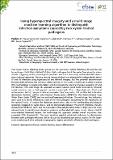Por favor, use este identificador para citar o enlazar a este item:
http://hdl.handle.net/10261/268194COMPARTIR / EXPORTAR:
 SHARE
BASE SHARE
BASE
|
|
| Visualizar otros formatos: MARC | Dublin Core | RDF | ORE | MODS | METS | DIDL | DATACITE | |

| Título: | Using hyperspectral imagery and a multi-stage machine learning algorithm to distinguish infection symptoms caused by two xylem-limited pathogens |
Autor: | Poblete, Tomás; Navas Cortés, Juan Antonio ; Camino, Carlos CSIC ORCID; Calderón Madrid, Rocío CSIC ORCID CVN; Hornero, Alberto CSIC ORCID; González-Dugo, Victoria CSIC ORCID; Landa, Blanca B. CSIC ORCID | Palabras clave: | Hyperspectral Thermal Machine learning Disease-differentiation |
Fecha de publicación: | abr-2021 | Citación: | 3rd European Conference on Xylella fastidiosa (2021) | Resumen: | Two major threats affecting olives groves are the bacterium Xylella fastidiosa (Xf) and the soil borne fungus Verticillium dahliae (Vd) Kleb. Both pathogens block the water flow along the xylem vessels, triggering similar physiological symptoms which are also easily confounded with water-stress induced responses. Previous remote sensing studies have attempted to independently detect Xf and Vd infections using hyperspectral and thermal imagery, but the potential discrimination between both infections has not been addressed yet. In this study, a multistage machine learning (ML) methodology is proposed to detect and discriminate the spectral changes caused by Xf and Vd infection. The multi-stage ML approach assessed spectral plant traits retrieved by physical model inversion such as leaf pigment content (carotenoids, Cx+c, chlorophyll a+b, Ca+b and anthocyanins, Anth.), canopy structural parameters (leaf area index, LAI and the leaf inclination distribution function, LIDFa), solar-induced fluorescence (SIF@760), the thermal-based Crop Water Stress Index (CWSI) and narrow-band hyperspectral indices. On each stage, key indicators were used to i) detect infection by each of the two pathogens accounting for the importance of the spectral traits, ii) reduce the detection uncertainties due to the confounding physiological responses triggered by water stress, and iii) discriminate between Vd and Xf infections. Results showed that SIF@760, Anth. and the Normalized Phaeophytinization Index (NPQI) were the most relevant traits to identify trees showing symptoms confounded with water stress. Using a Vd+Xf cross-infected balanced dataset the multi-stage ML approach yielded overall accuracies that exceeded 92% (kappa=0.8). The most sensitive spectral plant-trait indicators to discriminate between both pathogen infections will be discussed, describing operational aspects for the large-scale monitoring of olive orchards in geographic regions potentially affected by both pathogens. | Descripción: | Trabajo presentado en la 3rd European Conference on Xylella fastidiosa (Building knowledge, protecting plant health), celebrada online el 29 y 30 de abril de 2021. | Versión del editor: | https://doi.org/10.5281/zenodo.488454 | URI: | http://hdl.handle.net/10261/268194 | DOI: | 10.5281/zenodo.488454 | Identificadores: | doi: 10.5281/zenodo.488454 |
| Aparece en las colecciones: | (IAS) Comunicaciones congresos |
Ficheros en este ítem:
| Fichero | Descripción | Tamaño | Formato | |
|---|---|---|---|---|
| xylem-limited_pathogens_presentacion.pdf | 3,32 MB | Adobe PDF |  Visualizar/Abrir | |
| xylem-limited_pathogens_resumen.pdf | 162,22 kB | Adobe PDF |  Visualizar/Abrir |
CORE Recommender
Page view(s)
107
checked on 29-abr-2024
Download(s)
54
checked on 29-abr-2024
Google ScholarTM
Check
Altmetric
Altmetric
Este item está licenciado bajo una Licencia Creative Commons

